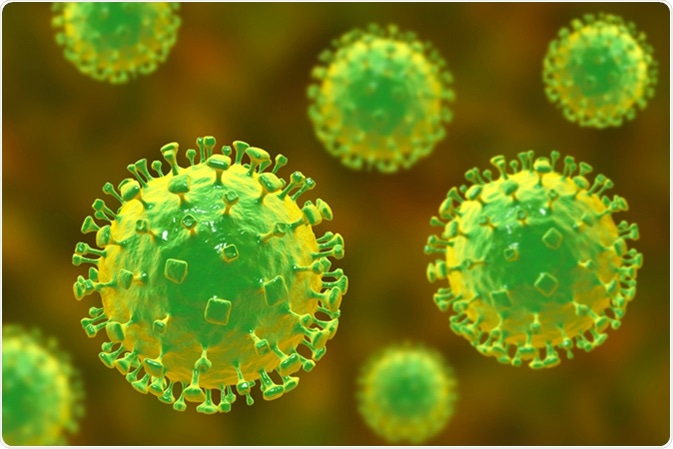Nipah virus is the causative agent of the Nipah virus infection, an emerging zoonotic disease first reported after an outbreak in Malaysia in 1998.

Nipah virus, newly emerging zoonotic infection with acute respiratory syndrome and severe encephalitis, 3D illustration. Image Credit: Kateryna Kon / Shutterstock
Nipah Virus Overview
Nipah virus (NiV) is a zoonotic virus, which is a virus that can be transmitted from animals to humans. Evidence has shown that fruit bats and pigs host the virus which can lead to serious illness in both animals and humans.
Though the first outbreak occurred in Kampung Sungai Nipah, Malaysia, all succeeding outbreaks were reported in Bangladesh, India, and Singapore. The infection is highly dangerous as it attacks the brain and has the potential to send those infected into a coma within just 24 hours.
In May 2018, an Nipah virus outbreak was reported in India, which rapidly spread amongst the population and claimed the lives of 17 people, with 18 confirmed cases. Death can occur in up to 80% of cases, making it a very deadly virus.
Mode of Transmission
Humans can develop Nipah virus if they come into contact with the excrement of infected animals. Originally, pigs were thought to be the primary host of NiV, however, fruit bats were later found to harbor the virus. In Malaysia and Singapore, the outbreaks reported were caused by the transmission of the virus from bats to pigs, with subsequent transmission occurring between pigs and humans.
However, the recent outbreak in 2018, has been linked to the consumption of mangoes which had been bitten by infected pigs. It was also reported that some individuals were infected due to ingesting raw date palm that had been contaminated with bat saliva containing NiV.
The outbreaks in Bangladesh and India have cases of person-to-person transmission. These transmissions were seen to occur due to direct contact with bodily fluids of patients with the virus.
Virus Hunter: Monitoring Nipah Virus in Bat Populations | HHMI BioInteractive Video
Signs, Symptoms and Complications
The incubation period of the Nipah virus ranges from five to 14 days, but there have been reported cases of incubation periods lasting as long as 45 days. The contagious period of the infection begins during the incubation period as evidenced in research examining the virus in pigs Patients usually develop a sudden onset of flu-like symptoms including fever, headache, respiratory difficulties, convulsions, coughing, and vomiting.
A complication of the infection is encephalitis, a deadly inflammation of the brain, which is characterized by periods of disorientation, drowsiness, mental confusion, seizures and altered consciousness. Additionally, if the virus is not detected early, then further complications such as respiratory infections and atypical pneumonia may develop. These symptoms can progress quite rapidly, within just 24 to 48 hours, to coma and eventually death.
In the fourth outbreak of the infection, one clinical feature was acute respiratory distress syndrome (ARDS). ARDS is a potentially life-threatening condition where an individual’s lungs can’t provide their organs with the amount of oxygen they require. Nipah virus can also lead to a rapidly progressive disease that targets the nervous and respiratory systems.
Treatment
There is currently no cure or vaccine to treat the Nipah virus. Treatments are limited to supportive care to treat the emerging signs and symptoms of the illness. If further complications are seen, consideration needs to be taken to treat possible cases of encephalitis which can be transmitted from one person to another. Therefore, it’s important to implement standard infection control practices to limit transferal.
Moreover, proper barrier nursing techniques should be implemented to prevent nosocomial transmission, which are hospital-acquired infections. Patients are expected to make a full recovery after surviving acute encephalitis. But, in some cases, survivors had long-term neurological disorders such as seizures and personality disorders.
Prevention
Since there is no available vaccine for the Nipah virus, prevention is important to stop the spread of the virus and the onset of its deadly symptoms.
As the primary host of the infection is fruit bats, it’s essential to avoid consuming foods that may have been contaminated by them. Also, people who own domestic or farm animals should prevent them from eating contaminated fruits. Furthermore, it is suggested that people should avoid eating the sap of date palm which has been found to often contain the virus.
In a hospital setting, healthcare professionals should take the necessary sanitation procedures to avoid cross infection, such as wearing a gown, mask, cap and gloves and washing their hands.
The Nipah virus infection can cause severe disease in those who become infected. Due to a lack of cure or vaccine being available, preventive and precautionary measures need to be taken to reduce the likelihood of transmission between animals and humans, and person-to-person.
Further Reading
Last Updated: Feb 27, 2019